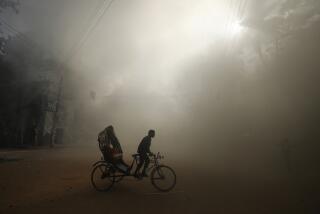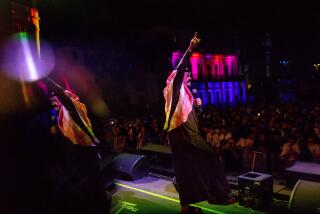Troops, police assault protesters in Bahrain’s capital
- Share via
Manama, Bahrain, and Riyadh, Saudi Arabia -- — Military troops and police moved against thousands of anti-government protesters occupying a landmark square in Bahrain’s capital early Wednesday after the king had declared a three-month state of emergency and instructed the military to battle unrest in the strategic nation.
The security forces fired tear gas and shotguns as they pushed into Pearl Square, and at least two people were killed, eyewitnesses said. An army ambulance with its light flashing was seen leaving the area.
“When they started shooting shotguns, we immediately went back,” said Sayed Fadel. “All we had were rocks and sticks.”
At a makeshift aid station at a mosque near the square, two casualties lay on the carpeted floor receiving medical care.
Abdullah Alshar, said he was struck by shotgun pellets outside his house a few blocks from the square as security forces pushed demonstrators back. His torso and arms were covered with small bloody wounds. Most of the more seriously wounded had been taken from the mosque to a nearby hospital, volunteers said.
Four tanks and half a dozen other armored vehicles were positioned 300 yards from Pearl with soldiers manning machine guns, and helicopters circled the area but didn’t immediately intervene. Dozens of soldiers milled about casually outside the square as smoke rose. More than 20 white buses stood nearby, apparently used to transport the riot police who were blocking access to the square.
Army vehicles were also visible on an overpass leading into Manama’s downtown financial district. The troops apparently seized the road from protesters, who had sealed off the road in recent days and turned parts of the city into a ghost town.
On Tuesday, at least two other civilians and a soldier were killed when clashes erupted across the island nation that hosts the U.S. Navy’s 5th Fleet.
The king imposed the state of emergency Tuesday as sectarian strife deepened, inflaming tensions between the region’s largest rivals, Iran and Saudi Arabia.
After the declaration of martial law by King Hamed ibn Isa Khalifa, Bahrain’s armed forces said they would launch a “crackdown on lawbreakers,” referring to the protesters, predominantly Shiite Muslims.
“Certain locations will be evacuated and rallies disrupting the public order will be banned,” a statement by the Bahrain Defense Force said. “Suspects will also be tracked down and arrested to face charges.”
A day earlier, Saudi Arabia sent forces to help quell the growing unrest. But there was no sign of them among the military vehicles flying Bahrain’s flag Wednesday. It was unclear what specific role the Saudi forces and police units from other Persian Gulf countries would play in the effort to quell the protests.
There were reports that violence had flared outside the capital, in the predominantly Shiite Muslim area of Sitra and other suburban neighborhoods and villages. At least two deaths were reported in the clashes; as many as 200 were injured.
The Associated Press reported that a Saudi sergeant had been shot and killed by a protester in Sitra, according to Saudi security officials. The report could not be immediately confirmed.
The Saudi involvement, however, highlighted how a conflict that began over local grievances was evolving into a contest between Saudi Arabia and Shiite-run Iran for influence in Bahrain, which has a majority Shiite population.
Iran stepped up its denunciation of Saudi Arabia’s move to shore up Bahrain’s monarchy.
“The presence of foreign forces and interference in Bahrain’s internal affairs is unacceptable and will further complicate the issue,” Foreign Ministry spokesman Ramin Mehmanparast said Tuesday at his weekly news conference in Tehran, according to news reports.
The Saudi presence was also denounced by some of Bahrain’s Shiite opposition leaders, who described the presence of foreign troops as an “occupation.”
Near Pearl Square on Tuesday, demonstrators who had occupied the traffic circle since last month had constructed more barricades. Several young men at the barriers said they would try to block police or military units from entering.
In other suburban neighborhoods populated largely by Sunnis, young men carrying sticks and metal rods, many with their faces covered, blocked roads and examined cars.
“We are defending our homes from the Shia people,” said one young man carrying a wooden club, who declined to give his name.
He and several associates had blocked a road in the suburb of Riffa, a mostly Sunni neighborhood that includes several palaces used by the ruling family. An Interior Ministry policeman sat in his truck near the checkpoint, apparently unconcerned.
After Wednesday’s assault, dozens of young men ousted from Pearl Square milled around the neighborhood of Sanabis, a predominately Shiite area a few blocks away.
Many said they feared the police would push further into their neighborhood in a broad crackdown on the Shiites.
Iran and Saudi Arabia have long been rivals for a variety of religious and political reasons. Each country bases its legitimacy on Islamic law, but Iran subscribes to a rigid interpretation of Shiite Islam, and the Saudis follow a highly conservative form of Sunni Wahhabism.
“There’s an ideological competition between the two countries to represent Islam,” said Turki Hamad, a columnist for the Saudi newspaper Al Watan.
Iran has long made claims to Bahrain, while Saudi Arabia has seen the island as part of its sphere and has been a key patron of the royal family. The Saudis fear that the neighboring unrest may fuel protests among its own Shiite population, which is largely in the nation’s oil-rich province next to Bahrain.
It remains unclear whether the Iranians have penetrated Bahrain’s protest movement, which has tried so far to avoid a sectarian cast. Many protesters in Pearl traffic circle say they have no desire to see Bahrain come under Iranian influence.
But many Saudis are convinced that the campaign is guided by Iran, as Shiite movements in Bahrain and elsewhere in the region have been for 30 years, independent analysts said.
“The Bahraini Shia will take over with the help of Iran and then Iran will annex it. They will never acknowledge the independence of Bahrain. It will become like one of the other islands off its coast,” said Abdullah Askar, history professor at Riyadh’s King Saud University and vice chairman of the foreign affairs committee of the king’s Consultative Council.
A military confrontation between Saudi Arabia and Iran over Bahrain is unlikely. But if clashes between Saudi troops and Bahraini protesters intensify, Iran could use proxies and other covert means to mount attacks in Bahrain, analysts said,
“If protesters target Saudi soldiers or march on the Saudi Embassy and if the Iranians start escalating their response, you could have another Lebanon 20 miles away from the Saudi border and right on the United States’ doorstep with the 5th Fleet,” said Rachel Bronson, vice president of programs and studies at the Chicago Council on Global Affairs.
Cloud reported from Manama and Banerjee from Riyadh. Times wire services contributed to this report.
More to Read
Sign up for Essential California
The most important California stories and recommendations in your inbox every morning.
You may occasionally receive promotional content from the Los Angeles Times.












